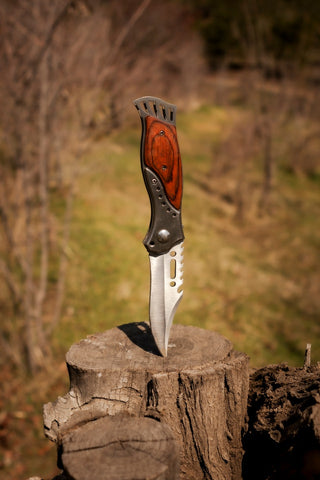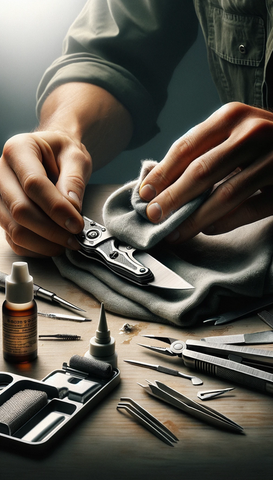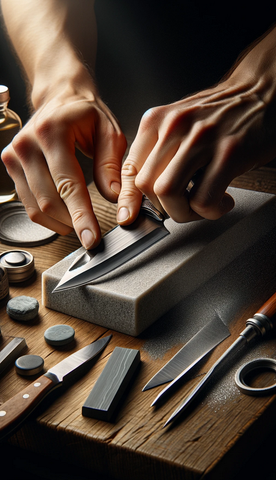Your Cart is Empty
FREE Shipping WORLDWIDE | $5 OFF Use Code SURF5BUCKS

A pocket knife is an essential tool, whether you're an outdoor enthusiast, a handyman, or just someone who values preparedness. But like any tool, it's only as good as its care and maintenance. A well-maintained knife will serve you well for many years, and it's easier than you might think to keep it in top shape.
Cleaning, sharpening, and maintaining your pocket knife isn't just about prolonging its life. It's also about ensuring it's safe and effective to use. A dull or dirty knife can be more dangerous than a sharp one, and a poorly maintained knife can let you down when you need it most.
It's easy to overlook pocket knife's everyday grooming, but this small tool's maintenance plays a crucial role in retaining its functionality and longevity. This section will explicitly outline why cleaning, sharpening, and maintaining your pocket knife is vitally important.
Visit any experienced outdoor enthusiast's lair, and you'll find one common element - their trusted pocket knife. These handy tools aren't just objects of convenience; instead, they're lifelines in unanticipated survival situations. However, the notion of a pocket knife being a "lifeline" can only stay true if the tool is well-maintained, sharp, and clean.
Frequent cleaning of a pocket knife eliminates any dirt, dried liquids, or residue that might have settled on the blade or in the crevices. Contaminants like these, if left unattended, don't just affect the knife's functionality, but also pose a risk of rusting or corroding the blade.
A rusty or corroded blade will, in most cases, become weak and may fail you during crucial tasks. It's a seemingly insignificant chore that effectively prolongs the lifespan of your pocket knife indefinitely and keeps it running like brand new.
Similar to cleaning, sharpening your pocket knife is a maintenance task that pays off in dividends. A well-honed blade increases safety by reducing the need for unnecessary pressure during cuts, which could otherwise lead to accidental injuries. Furthermore, a sharp knife makes for precise and efficient cutting, carving, slicing which is useful in various everyday tasks and essential survival situations.

Lastly, overall maintenance extends beyond just cleaning and sharpening. It involves periodic checks for loose screws, broken parts, and immediate fixes. Regularly maintained knives have improved reliability, ensuring your tool won't fail when you need it the most.
Each step of maintaining a pocket knife _ be it cleaning, sharpening, or inspecting for damage _ carries essential benefits. It's an ongoing process and not a one-time job but, without a doubt, an endeavor that's worth every bit of your time and effort.
For anyone serious about preserving their pocket knife, having the right set of tools can make all the difference. Here's a rundown of essential tools needed for effective knife maintenance.
Cleaning your pocket knife requires some specific tools that depend on the level of dirt and grime. Some of the basics include:
With these tools, you'll be able to keep your knife pristine and in optimal working condition.
Keeping a knife's edge sharp is critical for its utility and safety. An array of sharpening tools might be used. Consider:
Choosing the correct sharpening tool is a matter of personal preference, but having at least one available ensures the knife stays sharp and reliable.
Regular maintenance of a pocket knife goes beyond mere cleaning and sharpening. Having a handy set of maintenance tools can help extend the life of your knife. Some valuable tools could be:
By investing in these tools, a pocket knife owner can make sure their trusty tool remains safe, efficient, and ready for any task. Remember, a properly maintained knife will serve its purpose longer and more safely. Never underestimate the importance of proper knife care.
So, we've established the importance of maintaining your trusty pocket knife. But, how exactly should you go about this cleaning process? Fret not. This step-by-step guide simplifies the job ensuring your knife stays in tip-top shape.

Firstly, assemble your cleaning materials. This must include a gentle solvent, a toothpick for tiny crevices, and a microfiber cloth. Having all this at arm's reach before starting ensures a fluid cleaning process.
Next, wipe the knife with the solvent. Dip the cloth in your chosen solvent and give the entire knife a good wipe. Keep in mind, it's important to be gentle to avoid accidentally damaging the knife. Solvent loosens any stuck dirt and residue enhancing its overall performance.
Third, engage the toothpick. It's small and perfectly designed to reach the tiny nooks and crannies on your knife. Use it to remove accumulated dirt or residues in those unreachable spots. It's an easy yet effective step in securing the longevity of your pocket knife.
Move on to the blade's grip. It's often overlooked but equally susceptible to residue buildup. Clean this part as thoroughly as the blade itself.
Lastly, dry your knife thoroughly. Dampness can lead to rust. Use a dry microfiber cloth ensuring every part of the knife is dried off. It's not an exaggeration to say this might be the most important step in the entire cleaning process.
However, cleaning alone doesn't suffice to keep a pocket knife in optimal condition. Sharpening and overall maintenance are equally crucial so let's delve into those topics next. Remember, it's more than cleaning; it's maintaining a vital tool in your everyday life. Let's explore how to sharpen it effectively and why it matters so much.
Sharpening a pocket knife is just as important as cleaning it. A well-sharpened knife is safer to use, performs better, and lasts longer. From professionals who use their knives on a daily basis to occasional outdoor enthusiasts - everyone can benefit from a sharp blade. Here's a simple, foolproof guide to keeping that pocket knife razor-sharp using an oil stone or a honing rod only.
Firstly, it's essential to get your hands on a high-quality sharpening tool. It could be an oil stone or a honing rod. The sharpening stone should ideally have both coarse and fine grit sides. The coarser side is for initial sharpening, while the finer side helps achieve that perfect edge.
Kick off the sharpening process with the coarse side of the stone. Begin by applying a few drops of oil on it for lubrication. Subsequently, hold the knife at an approximate 20 degrees angle. Drag the blade across the stone in a smooth motion from the knife's heel to the tip. Make sure to maintain the angle and steady pressure throughout. Ensuring consistent sharpness involves repeating this process about 5-10 times on each side of the blade.

After you have sharpened both sides using the coarse grit, it's time for the fine grit side. Repeat the process above but with fewer strokes. This step is called honing, it'll provide a razor-sharp edge and a polished finish to your pocket knife.
Bear in mind that sharpening a pocket knife is not a one-and-done deal. It needs regular maintenance for optimum performance. A general rule of thumb is to hone the knife once a week (or after intensive use) and thoroughly sharpen it at least twice a year.
Sharpening a pocket knife might seem intimidating at first, but with practice, it's a task that not only is achievable but can also be quite satisfying. Following these steps will ensure a keen blade, ready for any task at hand. Here, you've mastered how to clean, and sharpen, now let's move right along to maintaining your pocket knife.
Maintaining a pocket knife isn't just about cleaning or sharpening. Rather, it's about ensuring the longevity and functionality of this handy tool. This process involves some basic yet crucial tasks, regular inspections, proper storage, and careful handling, that even a beginner can master with minimal effort.
Ensuring routine inspections is the first key to proper maintenance. Every once in a while, it is necessary to thoroughly inspect the knife for any signs of wear and tear. It helps in catching the early signs of rust before it gets worse.
The focus should be on the blade, hinge, and the handle. Remember, consistency is key in maintenance.
Proper storage is another critical element of maintenance. A common mistake many knife owners make is storing their tool in damp or humid places. Humidity can corrode and dull the knife's blade. Hence, it's vital to store the knife in a dry environment. Investing in a knife sheath or case might sound like a luxury, but these protective measures can significantly extend your pocket knife's lifespan and protect it from external damages.
Additionally, owners should also be aware of careful handling of their pocket knives. It's not a heavy-duty tool; overworking it might cause unwanted stresses leading to serious damage to the blade and hinge. So, be mindful of the jobs the knife is used for; it isn't a saw or a hammer.
Moreover, something as simple as keeping the pocket knife dry can save it from potential damage. After each use, especially if the blade got wet, it's crucial to wipe down the knife with a dry cloth to prevent rust.
Maintaining a pocket knife in peak condition isn't arduous or time-consuming. Instead, what's required is persistence and realization that proper care will enable the knife to retain its initial sharpness and functionality for a longer period.
In maintaining a pocket knife, common mistakes can lead to its degradation or even potential injury. Therefore, it's essential to have a grasp on these pitfalls to preserve the knife's functionality and longevity.
One frequent error is ignoring routine inspection. Many owners forget to perform this simple act. Checking the knife for visible signs of wear and tear is vital for its upkeep. More often than not, people tend to realize the deteriorating condition of their pocket knife too late when significant damage has already been done making restoration more arduous.
Incorrect storage too is an issue often overlooked. Storing a pocket knife in damp and humid conditions can promote rusting. With improper storage, minor issues can gradually snowball, resulting in a blunt or ineffective blade. Therefore, always store your knife in a dry, cool place, and always ensure it's dry before putting it away.
When sharpening, the most common mistake is using a coarse grit for a slightly dull knife. Not only is this unnecessary, but it can also shorten the lifespan of your blade. A ceramic or fine grit is usually sufficient to hone a slightly dull knife back to sharpness.

But remember, over-sharpening your pocket knife isn't beneficial either - it is a rather common and harmful mistake to make during maintenance. Regular and extreme sharpening whittles down the blade, reducing its useful life. You can avoid this by understanding the correct angle and pressure needed for your specific knife model while sharpening and refraining from overdoing it.
Another common mistake is handling the knife carelessly. It might seem trivial, but dropping your knife, using it as a screwdriver, or prying open cans can alter the blade's alignment and dull it over time. Always handle your knife carefully and it'll serve you well for years to come.
Bearing these points in mind can significantly prolong the life and quality of your pocket knife. These common mistakes are easily avoidable when one is conscious of their actions and their impact on the item in their hand - which, in this case, is a pocket knife that deserves careful handling and correct maintenance.
Safety should always be one's paramount concern when dealing with knives. Irrespective of their size, pocket knives can cause significant injuries if not handled appropriately.
Always point the blade away from you. It's temping to disregard this advice when cleaning a small pocket knife, but doing so could lead to preventable accidents. Whether you're just giving it a quick wipe down or deeply cleaning the mechanism, treating the knife with respect can prevent mishaps.
Use cut-resistant gloves. These offer an additional layer of protection and greatly reduce the risk of an accidental cut when cleaning and sharpening. They're not expensive and can be a priceless investment for safety.
Don't rush the cleaning or sharpening process. Pocket knives have complex, intricate parts that require precision and patience to care for properly. Hurrying through the process can not only damage the knife but also increase the risk of injury.
Maintain a secure grip. It’s essential to hold the knife securely whether cleaning, sharpening, or just checking it over. A slip could cause injury or damage the knife.
Keep your workspace clean and well-lit. Good lighting ensures you can see what you're doing. A clean area reduces the chance of mishaps from slipping or knocking things over.
Store your pocket knife properly. When not in use, ensure it's kept in a safe place out of reach of children. A closed knife should be stored in a dry place to prevent rusting.
Those interested in pocket knife longevity should note that these safety tips aren't just recommendations. They're essential steps in ensuring that their treasured tool remains in excellent condition, and the user stays safe. These concepts hint that careful attention and appropriate caution can go a long way in preventing any unwanted incidents during routine maintenance or cleaning processes of the knife. Longevity will result.
Taking care of your pocket knife isn't just about cleaning and sharpening. It's about maintaining it, too. This includes routine inspections, proper storage, and handling it with care. Avoiding common mistakes like over-sharpening or using the wrong grit can make a world of difference. Safety should always come first when dealing with pocket knives. Always remember to point the blade away from you, wear cut-resistant gloves, and keep your workspace clean and well-lit. Proper storage is also essential. By being mindful of these tips and tricks, you'll not only extend the life of your pocket knife but also improve its quality. So, don't just use your pocket knife - take care of it. It's an investment worth protecting.
ABOUT THE AUTHOR
Olivia Poglianich
Content Strategist
Olivia Poglianich is a nomadic brand strategist and copywriter in the surf, watersports and outdoor adventure space who has worked with brands such as Visa, Disney and Grey Goose. Her writing has taken her all over the world, from a Serbian music festival to a Malaysian art and culture event. Olivia is a graduate of Cornell University and is often writing or reading about travel, hospitality, the start-up ecosystem or career coaching. Her latest interests are at the intersection of web3 and communal living, both on and offline.
